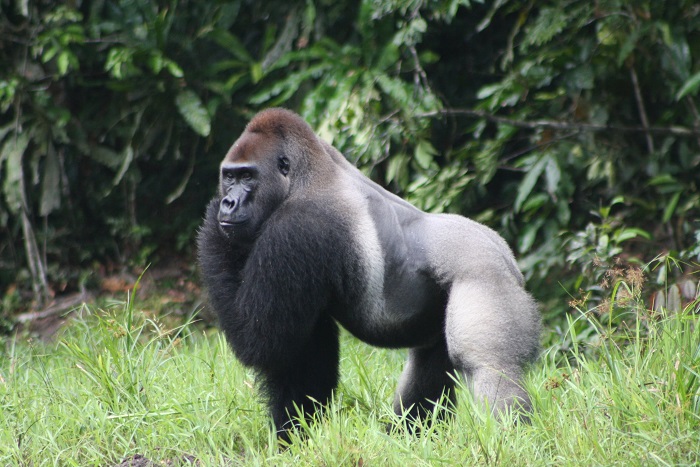The parlous state of eastern gorillas is matched by three of the other great ape species already listed as critically endangered, a classification that is just one rung above extinction. The western gorilla, the Bornean orangutan and Sumatran orangutan are classed as critically endangered. Chimpanzees and bonobos are deemed endangered.
“We are driving our closest living relatives to extinction, which is sickening,” said Dr M Sanjanyan, vice-president at Conservation International.
“If we can protect our large primary forests and make local and indigenous people the beneficiaries of that, we’ll continue to share the world with great apes. If we don’t, we’re done. We’ll have a few relics left but, ecologically speaking, the great apes will be gone.”
The eastern gorilla, or Gorilla beringei, is composed of two subspecies – mountain gorillas and Grauer’s gorilla – found in pockets of rainforest in Uganda, Rwanda and the Democratic Republic of Congo (DRC). While mountain gorilla numbers have rallied in recent years, just 800 of them remain. There are approximately 3,800 Grauer’s gorillas, down from about 20,000 in the 1980s.
The Rwandan civil war of the early 1990s “hammered” Grauer’s gorilla numbers, according to John Robinson, a primatologist at the Wildlife Conservation Society. Refugees moved into the ape’s heartland in the Kahuzi-Biéga national park, in the eastern DRC, set up small-time mining operations and turned to the gorillas as a source of meat. Civil unrest has also led to the illegal poaching of mountain gorillas.
While hunting and habitat disturbance have diminished apes in Africa, their counterparts in Indonesia and Malaysia have suffered from the cultivation of palm oil, which is used in many common food and cosmetic products. Indonesia has the most rapid deforestation rate in the world, leaving many orangutans dead, orphaned or captured by farmers.
“We are fighting on many fronts to save the apes,” said Robinson. “We are by far the most successful of the great apes and have pushed our cousins right up against the wall. We came out of the forest and converted those forests into other areas. Apes’ habitat preferences make it difficult for them to live in a human-dominated world.
“The idea of losing great apes is so difficult to comprehend that when push comes to shove I think we will invest resources into conserving them. But they really are down to the wire.”
Jane Goodall, the renowned primatologist, said that apes are facing huge problems around the world and blamed corrupt governments and the interests of big business for their plight. “Unfortunately, the progress we are making is on greater awareness – overall the numbers [of apes] are still falling,” she said.
“It’s worst in Indonesia with palm oil and the orangutans, but we are now seeing palm oil move into Africa. We’re also seeing a resurgence of chimpanzees in the pet trade we thought that had more or less stopped. Some of the protected places are working well, some aren’t. We will lose more apes, but we are not going to lose.”
The latest IUCN red list has better news for the giant panda, which has improved from endangered to vulnerable. Previously the subject of laboriously unsuccessful breeding programmes, pandas have benefited from efforts by the Chinese government to protect forests. However, climate change is a looming threat, with more than a third of the panda’s bamboo habitat set to disappear by the end of the century.
“This reclassification recognises decades of successful conservation efforts led by the Chinese government and demonstrates that investment in the conservation of iconic species like giant pandas does pay off – and benefits our society as well as species,” said Lo Sze Ping, chief executive of the China office of WWF, which has had a panda as its global logo since 1961.
“Everyone should celebrate this achievement, but pandas remain scattered and vulnerable, and much of their habitat is threatened by poorly planned infrastructure projects. And remember: there are still only 1,864 left in the wild.”
Australia, a hotspot for species extinctions, has made progress with the bridled nailtail wallaby, which has improved from endangered to vulnerable. But the koala is now listed as vulnerable when previously it wasn’t considered in danger at all, due to habitat loss, forest fires, drought and disease.
Elsewhere, the previously abundant plains zebra has moved from least concerned to near threatened due to a spike in hunting for meat and skins. A trio of antelope species found in Africa are also now near threatened for the same reason.
“Illegal hunting and habitat loss are still major threats driving many mammal species towards extinction,” said Carlo Rondinini, coordinator of the mammal assessment at Sapienza University of Rome.
Two plant species have been rediscovered in Hawaii, which is also the location of the IUCN congress that began on Thursday. Mark’s cyanea and hairy wikstroemia, both endemic to the US state, were both thought to be extinct but small numbers of each species were recently found.
In total, the IUCN assessed 82,954 plant and animal species, with 23,928 classed as threatened in some way. Of the 5,107 species considered critically endangered, around half are plants, with amphibians, molluscs and fish also having large numbers of species on the brink of extinction.
The IUCN congress has the theme Planet at the Crossroads, with many scientists at the gathering expressing alarm that a pernicious mix of climate change, habitat loss and hunting is driving what’s been termed the “sixth great extinction” of the Earth’s flora and fauna.
More about:
















































